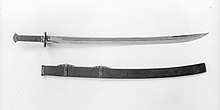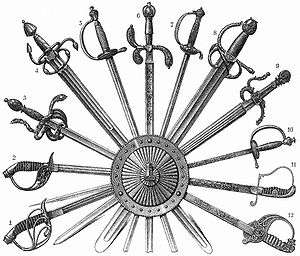Liuyedao
| Liuyedao | |||||||||||||
 A 17th–18th century liuyedao with gilt iron fittings at the Metropolitan Museum of Art[1] | |||||||||||||
| Traditional Chinese | 柳葉刀 | ||||||||||||
|---|---|---|---|---|---|---|---|---|---|---|---|---|---|
| Simplified Chinese | 柳叶刀 | ||||||||||||
| Literal meaning | willow leaf knife | ||||||||||||
| |||||||||||||
The liuyedao or willow-leaf saber is a type of dao that was commonly used as a military sidearm for both cavalry and infantry during the Ming and Qing dynasties. Many schools of Chinese martial arts originally trained with this weapon.[2] This weapon features a moderate curve along the length of the blade. This reduces thrusting ability (though it is still fairly effective at same) while increasing the power of cuts and slashes. It weighs from two to three pounds, and is 36 to 39 inches long.
References
Notes
Sources
- Tom, Philip M. W. (2001). "Some Notable Sabers of the Qing Dynasty at the Metropolitan Museum of Art". Metropolitan Museum Journal. 36: 11, 207–222. doi:10.2307/1513063.
- Tom, Philip with Scott M. Rodell (February 2005). "An Introduction to Chinese Single-Edged Hilt Weapons (Dao) and Their Use in the Ming and Qing Dynasties". Kung Fu Tai Chi, pp. 76–85
This article is issued from
Wikipedia.
The text is licensed under Creative Commons - Attribution - Sharealike.
Additional terms may apply for the media files.
